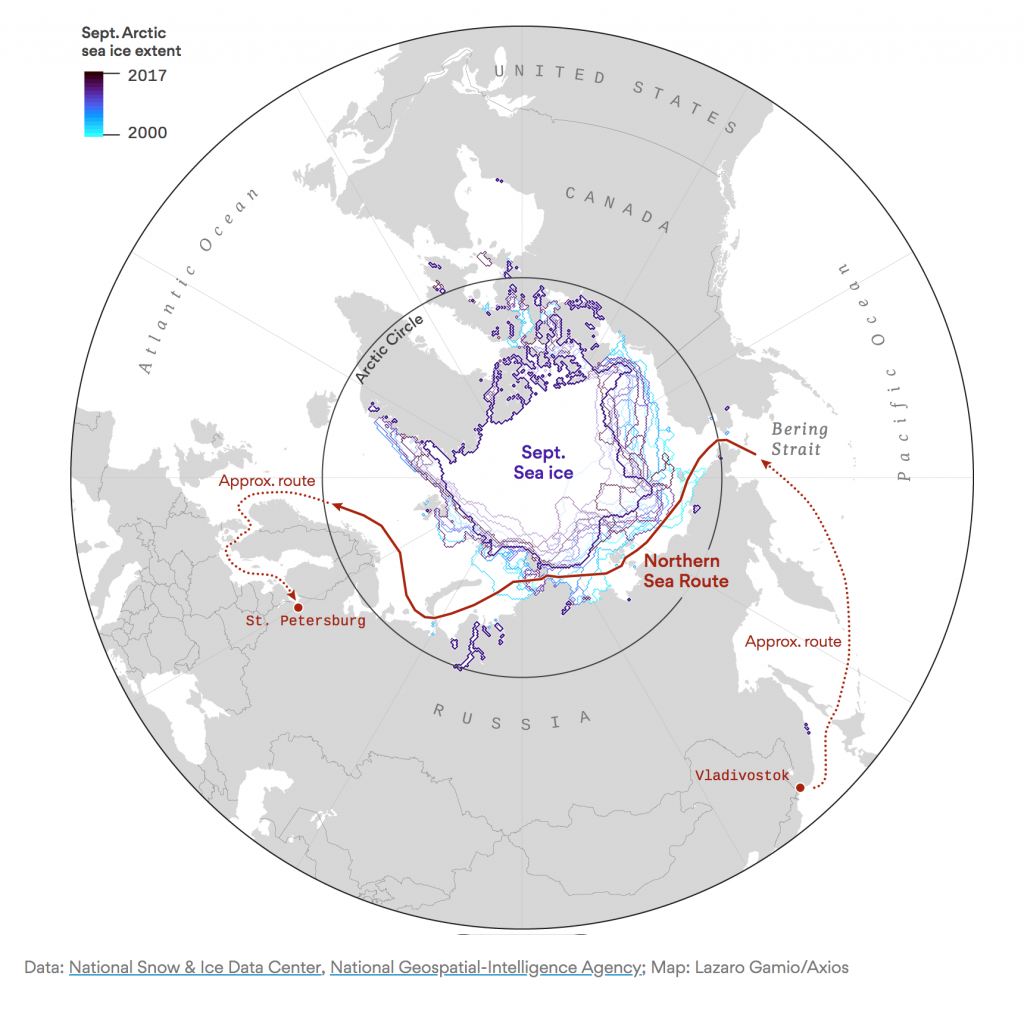Welcome to the New ‘New World’
“New World” is a phrase that was originated in 1503, by Italian explorer Amerigo Vaspucci, in the era of ships discovering North America. (Vaspucci was one of the first to realize that it was an entirely new continent, not just a new approach to the far East as Christopher Columbus believed.) With that addition of lands, resources, and global trade, our world was changed forevermore. This week, the Venta Maersk is a very different ship, on a very different route, that also heralds entering a “new world”, but of a different kind.
Venta Maersk is en route to St. Petersburg Russia, traveling the Northern Sea Route through the Arctic Ocean as shown on the polar map (credit AXIOS). Picking up seafood in Vladivostok Russia, she is now in Busan South Korea and will eventually unload in Russia’s main port of St. Petersburg in late September. The massive modern cargo ship is doing a trial of a new freight route taking advantage of the rapidly thawing Arctic Ocean. Arctic shipping routes have been opening up in recent years as global temperatures increase, but this is the first attempt at a commercial shipping route. The fact that it is Maersk, the world’s largest container shipping, company lends extra credibility.
This year has seen unprecedented melting of the Arctic sea ice as my readers and Twitter followers are well aware. Russia is building eight new ports along the northern frontier to take advantage of the new era. Due to the spin of the Earth and natural circulation patterns, the Arctic warms at double or triple the global average. It is now several degrees warmer than a century ago. Without question, this is due to the warming of our planet.
There are some similarities with what is happening now and the “new world” that was discovered five centuries ago:
- Centuries ago, the discovery of North America suddenly added vast unknown land and resources to the world of commerce; Today, the retreat of glaciers, particularly on the vast island of Greenland (about half the size of the continental U.S.), will effectively add considerable land, though slowly.
- New lands offer natural resources including fossil fuels and metals to be explored and mined.
With the opening of any new trade route, there will likely be winners and losers as new ports flourish and others are abandoned. Regardless, it is unlikely that there is any turning back to the way things were before.
Although this opening of new trade routes may be seen as a positive, there are dangers:
- As glaciers from Alaska to Greenland and Svalbard continue to melt at a hastening pace, producing icebergs, travel in the area will still be risky for many decades to come.
- The changing climate and warming that is causing the sea route to open will impact nearly every point on the planet with new weather dynamics including heavier rainfall, more severe droughts, more wildfires, and strange storm patterns.
- Impacts of the rapidly warming Arctic will bring harmful effects to the peoples and the ecosystems of the region.
- Geopolitical changes could be profound though hard to predict.
- As the melting of the Greenland ice sheet and glaciers accelerates–which it will–the resulting sea level rise will affect every port in the world.
On the face of it, what is happening now, likely seems small compared to the discovery of North America five hundred years ago. It will not take five hundred years for the events now unfolding in the Arctic to take center stage. In fact, I believe that in just fifty years, we will look back on the present day, as the transition to a truly new world. We probably cannot imagine the journey that lies ahead.


